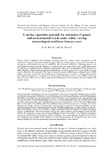| dc.contributor.author | Mayer, M | |
| dc.contributor.author | Musani, SK | |
| dc.date.accessioned | 2014-08-01T13:15:38Z | |
| dc.date.available | 2014-08-01T13:15:38Z | |
| dc.date.issued | 2002-04 | |
| dc.identifier.citation | Mayer, M., & Musani, S. K. (2002). A surface regression approach for estimation of genetic and environmental trends under widely varying meteorological conditions between years. Journal of Animal Breeding and Genetics, 119(2), 116-124. | en_US |
| dc.identifier.uri | http://onlinelibrary.wiley.com/doi/10.1046/j.1439-0388.2002.00317.x/pdf | |
| dc.identifier.uri | http://hdl.handle.net/11295/73521 | |
| dc.description.abstract | Under tropical conditions meteorological variations may be a major source of nuisance in the estimation of genetic and environmental progress achieved. In this paper an approach is presented to incorporate polynomial functions of rainfall in the statistical model for estimating genetic and environmental trends. The idea behind is to separate the year-season effect into causal components, i.e. influence of rainfall pattern, temporary management effect and environmental trend. Records on milk yield from a large commercial Jersey herd in Kenya covering a period of 14 years (1980–93) were used to illustrate this approach. The farm is located in upper midland agro-ecological zone of Rift Valley. It became evident that the rainfall pattern beginning one year prior to calving influenced the later milk performance in a complex way. The proposed model proved to be successful in separating the year-season effect into its causal components and thus gave better estimates of environmental and genetic trends. | en_US |
| dc.language.iso | en | en_US |
| dc.publisher | University of Nairobi | en_US |
| dc.title | A Surface Regression Approach For Estimation Of Genetic And Environmental Trends Under Widely Varying Meteorological Conditions Between Years | en_US |
| dc.type | Article | en_US |
| dc.type.material | en_US | en_US |

